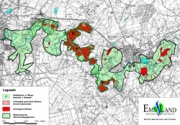Difference between revisions of "Haselünne"
From REFORM wiki
(→Key features of the case study) |
(→Monitoring before and after implementation of the project) |
||
| Line 14: | Line 14: | ||
==Monitoring before and after implementation of the project== | ==Monitoring before and after implementation of the project== | ||
A monitoring of the hydromorphological changes has been carried out by the University of Osnabrück, Department of Biology and Chemistry. | A monitoring of the hydromorphological changes has been carried out by the University of Osnabrück, Department of Biology and Chemistry. | ||
| + | |||
| + | ==Socio-economic aspects== | ||
| + | |||
| + | ==Contact person within the organization== | ||
| + | |||
| + | ==Extra background information== | ||
| + | |||
| + | |||
| + | ==References== | ||
| + | <references/> | ||
==References== | ==References== | ||
Revision as of 11:34, 19 April 2010
Haselünne
Key features of the case study

Project area, city of Haselünne in western part, map from http://www.haseauenverein.de/eunde.html
The main objective of the project was to re-connect the channel and the adjacent floodplain area and to re-connect side-channels. The total amount of money available for the project was 10.2 million Euro.
Monitoring before and after implementation of the project
A monitoring of the hydromorphological changes has been carried out by the University of Osnabrück, Department of Biology and Chemistry.
Socio-economic aspects
Contact person within the organization
Extra background information
References
References